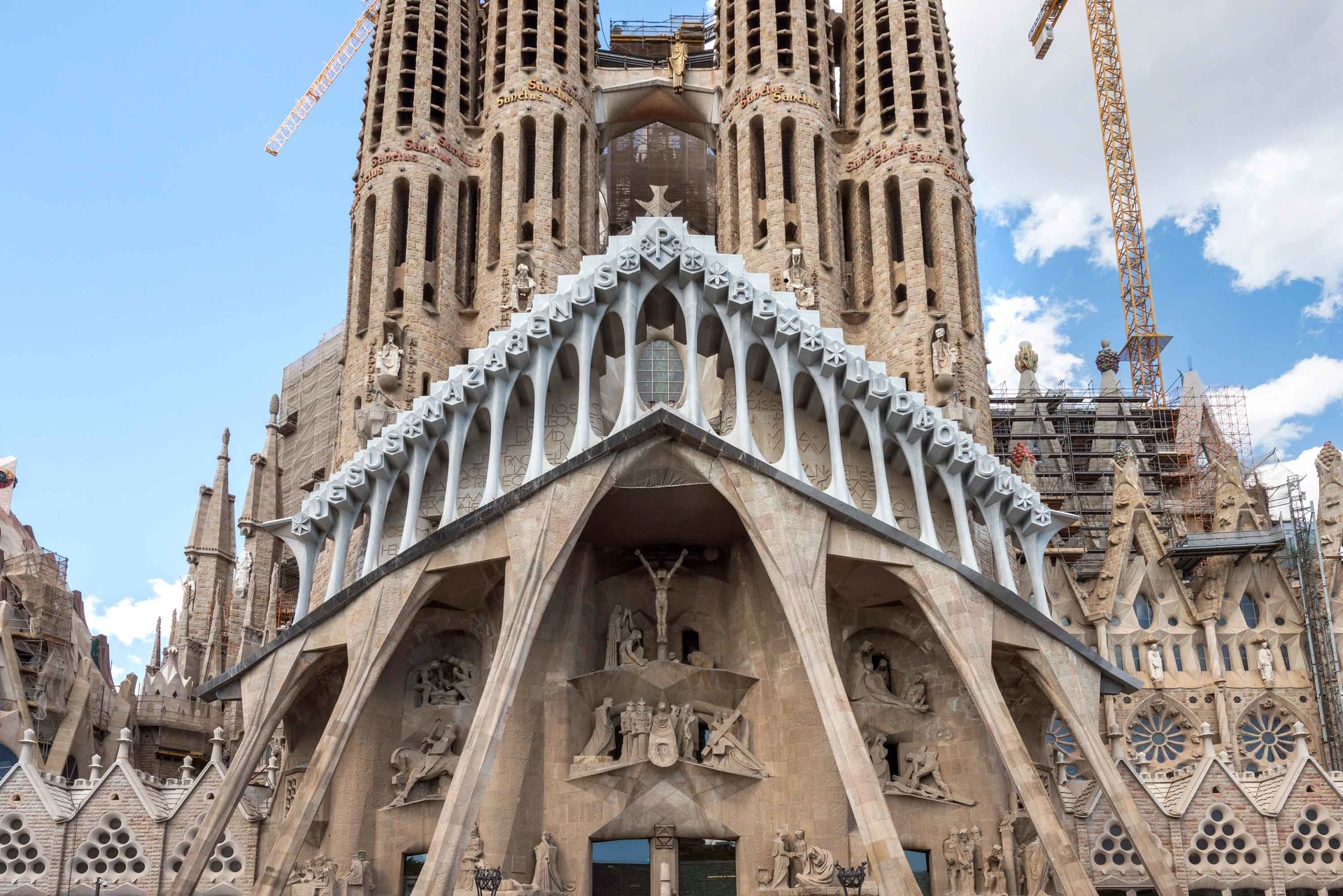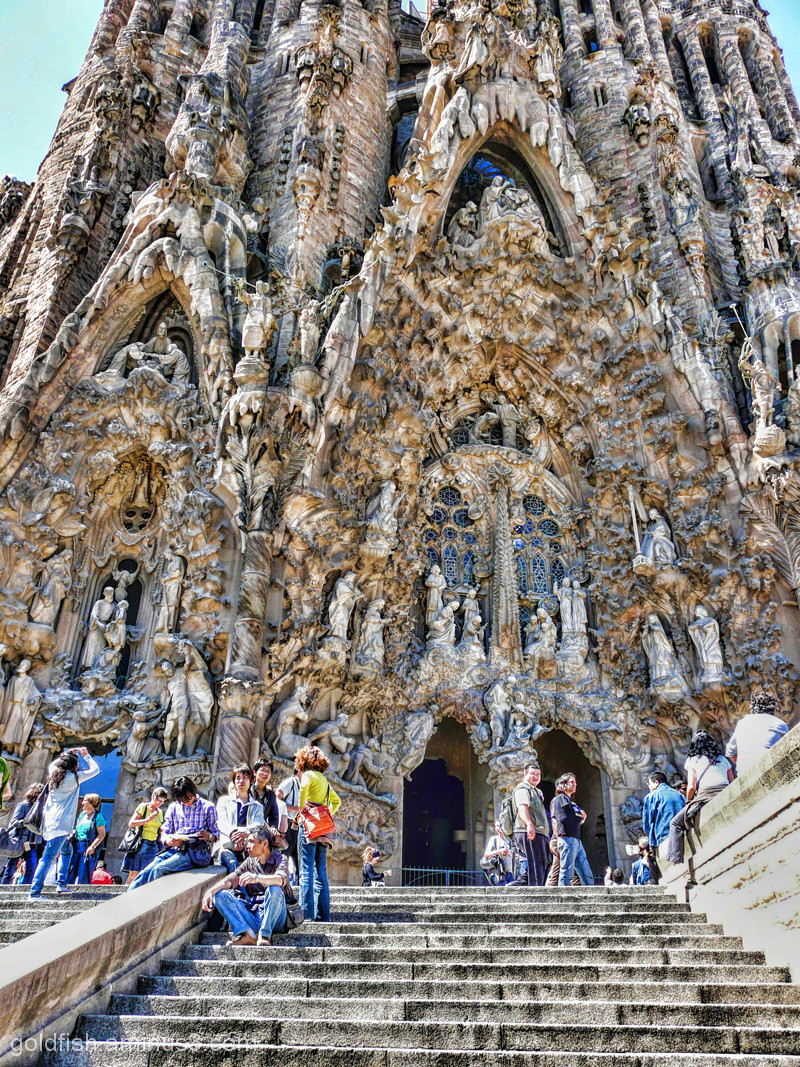The 8th wonder of the world
Is different the nature of The side of the Passione, built in the second half of the 900 and adorned with the art of Josep Maria Subirachs. The contrast of the two different architectural stile (even the different type of stone used) is really obvious, but seems that this difference was already planned in the original project of Gaudì. If indeed the previous side had the purpose to celebrate the joy of the Creation for the birth of the Savior, the current one represent the sufferences of Jesus for the humanity. The side of the Passion, was built in this way without excessive ornaments to focuse more on the different scenes that represent the last days of Jesus's life in the earth.

Without any doubts, it is a very hard style that Subirachs has modeled with the scultures, the sharp profiles are probably in antipodes with the idea of Gaudì that the the straight line should not be used as it does not exist in the natural world. However there is no doubt that the artist has suceed succesfully to convey the strong meaning implied by those scenes. It is not possible to look at the Crucifixion, the scene of the kiss of Juda or the one of the arrest of Christ and his agony carrying the cross without feeling really strong emotions.
Once again, as always when we talk about one of the creation of Gaudì, even the smallest details count. For example observe the box near the side of the scene of the Juda's kiss, in which there are written some series of numbers.
Naturally there is a specific meaning behind these numbers, I will not tell you which one because it is quiete easy to discover ( we can say that it refers to a sort o Sudoku ante litteram... )
Further elements of interest can be found in the box right behind of the Crocifixion. If you visited the Pedrera, you can't help to notice that the silhouette of the Roman soldiers standing on the left was outlined on the basis of the sculptures that are on the roof of Casa Milà. Instead it is impossible to guess that the face of the man standing on the left, depicting the evangelist who witnesses the scene (John), was shaped using a photograph of Gaudí himself. A sort of hidden homage that Subirachs wanted to pay to the great master, in short. Finally, notice how the chronological order of the scenes is a sequence that starts from the Last Supper, located in the lower left, then moves to the right and goes up to the second and third levels, forming a sort of S.
For what concern the inside of the church, it is not less extraordinary in comparison with the exterior. Once you cross the front door ( do not forget to notice the engravings on the door and on the floor immediatly in front of the entrance of the church), within a few seconds you will be lost in the wonder, once again feeling a sort of spiritual ecstasy. The splendid light that filters through the stained glass windows is the first thing that catches one's eye: according to Gaudí's conviction, the light in the churches must not be excessive, but rather present in the right measure to make worship, contemplation and meditation possible. The atmosphere is therefore quite subtle, yet truly enchanting.
You better rent an audioguide to better undertand the details of this extraordinary church. However some elements are so evident that can be noticed even from the eye of inexpert tourist like myself. The columns, are made using 4 different type of stones, which differ also in the color. Enjoy the armony of the temple, however this variety concur to it's uniqueness.
The main entrance is located in the east side, where is a statue of Sant Jordi (Saint Giorgio, patron saint of Catalonia). Not by chance, is the side in which the sun rise everyday, putting a stream of light in the church. Instead no stream of light comes from the opposite side, where is located the statue of Christ on the cross , surrounded by a series of ears of wheat and bunches of grapes. I advise you to pause for a moment in front of this sacred image. Although the colorful light of the windows creates such an enchanting effect that they remain fascinated and even bewitched, be sure to note the peculiar structure of the columns. In fact looking up at the ceiling, you will have the impression of seeing a forest of thin branches, an effect created by the ramification of the columns that resemble, in this way, very high stone trees.
As I told you from the beginning the church is far from being done, even if you think that could be ready by 2030. The principal part that are missing is without any doubts the third and last side, called The side of Glory, where will be celebrated the resurrection of Jesus. The only part that is visible right now are some colorful pinnacles, very similar to the ones of Palau Guell, that Gaudì would have certainly appreciated. Another important missing thing is that of the towers: the original project it foresees 17, very similar one to the others, plus one very extraordinary, that should reach 170 meters. However only 8 of the towers are built, excluded the tallest one. A very compelling challenge that has been taken.

Again, the towers deserve further attention, given that their number and disposition is anything but casual (since it is Gaudí, on the other hand, it would have been impossible). The 12 towers placed on the three sides symbolize (or better they will symbolize, since only 8 of them have been made) the apostles, while the higher one will obviously be emblem of Christ . Around it, 4 additional towers will represent the evangelists, while one last tower, towering above the apse, will be the symbol of the Madonna.
Given his notorious aversion to the straight line, Gaudí gave the towers a particular curvilinear profile. It is said that the source of inspiration for such a peculiar shape was the strange peaks of the mountains of Montserrat .
Concering the decorations, the existing towers are characterized by spectacular spiers covered by mosaic . In response to the observation that no one can see such elaborate decorations, it seems that Gaudí have said "the angels will see them" .
This curious (but very explicative) clarification brings me back to the personal observations I was making at the beginning. I will settle for adding a couple of things, to avoid this post becoming endless as the current condition of the Sagrada Familia (although way less fascinating).
Of course, everyone is free to visit the temple in the way they prefer. However, a full understanding of the original project (which we hope will become reality within a few decades) will not be possible without taking into account the spiritual component of this place. Finally coming at the conclusion of this post (although there is still much to be said about the crypt, the apse, the small but interesting cloister called the Roster's Claustre), I would like to conclude with a parallelism drawn from the biblical tradition. I like to think, in fact, that if the Tower of Babel was built with the aim of reaching the sky, thus demonstrating the power of the human race, an extraordinary building like the Sagrada Familia, while perhaps challenging the artistic and architectural, aims to bring humanity closer to God .
Photo gallery
Content available in other languages
- English: L'ottava meraviglia del mondo (1)
- Español: La octava maravilla del mundo (1)
Rate and comment about this place!
Do you know La Sagrada Familia? Share your opinion about this place.

















